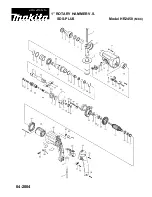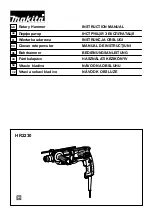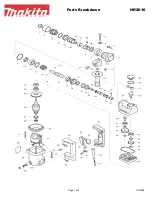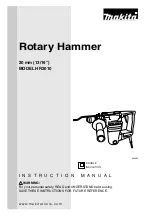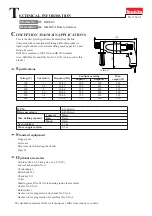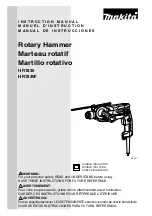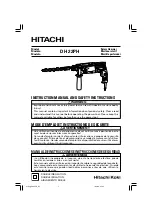
12
13
SIMBOLOGIA
Volts
Corrente direta
RPM sem carga
BPM
Golpes por
minuto sem carga
Selo da segurança elétrica
Leia o manual do operador
Use óculos de proteção
Use protetor auricular
MANUTENÇÃO
ACESSÓRIOS
Para obter uma listagem completa de acessórios,
consulte o catálogo de ferramentas elétricas da
MILWAUKEE ou visite www.milwaukeetool.com.
Para obter o catálogo, entre em contato com o seu
distribuidor local ou com uma assistência técnica
autorizada.
Manutenção das ferramentas
Manter a ferramenta, a bateria ou o carregador em
bom funcionamento adotando um programa de
manutenção regular. Depois de seis meses a um
ano, dependendo do uso, enviar a ferramenta, a
bateria e o carregador para a assistência técnica
da MILWAUKEE nos seguintes casos:
• Lubrifi cação
• Inspeção mecânica e limpeza (engrenagens,
eixos, mancais, caixa, etc.)
• Inspeção elétrica (botão, cabo, blindagem, etc.)
• Teste para assegurar a operação mecânica e
elétrica adequada
Se a ferramenta não iniciar ou funcionar na potên-
cia total com a bateria totalmente recarregada,
limpar os contatos da bateria. Se a ferramenta não
funcionar adequadamente, enviar a ferramenta, a
bateria e o carregador para conserto na assistên-
cia técnica da MILWAUKEE.
AVISO
Para reduzir o risco de lesão
pessoal e danos, nunca imergir a fer-
ramenta, a bateria e o carregador em líquido
nem permitir que entre líquido em seu interior.
AVISO
Para reduzir o risco de lesões,
sempre desligar o carregador da tomada
e remover a bateria recarregável do car-
regador ou da ferramenta antes de realizar
qualquer manutenção. Nunca desmontar a
ferramenta, a bateria ou o carregador. Entrar
em contato com a assistência técnica MIL-
WAUKEE para TODOS os consertos.
AVISO
Sempre remover a bateria recar-
regável antes de mudar ou remover
acessórios. Usar apenas acessórios especifi -
camente recomendados para esta ferramenta.
Outros acessórios podem ser perigosos.
Limpeza
Limpar a poeira e os detritos dos respiradouros do
carregador e da ferramenta. Mantenha os cabos da
ferramenta limpos, secos e sem óleo ou graxa. Usar
apenas sabão leve e um pano úmido para limpar a
ferramenta, a bateria e o carregador, porque certos
agentes de limpeza e solventes são prejudiciais para
os plásticos e outras partes isoladas. Alguns deles
são gasolina, terebintina, diluente de laca, diluente
de tintas, solventes clorados, amônia e detergen-
tes domésticos que contêm amônia. Nunca usar
solventes infl amáveis ou combustíveis em torno
das ferramentas.
Reparos
Se a ferramenta estiver danifi cada, envie-a para
a assistência técnica autorizada mais próxima.
PERSONAL SAFETY
GENERAL POWER TOOL SAFETY WARNINGS
WORK AREA SAFETY
ELECTRICAL SAFETY
• Keep work area clean and well lit.
Cluttered or
dark areas invite accidents.
• Do not operate power tools in explosive atmo-
spheres, such as in the presence of fl ammable
liquids, gases or dust.
Power tools create sparks
which may ignite the dust or fumes.
• Keep children and bystanders away while
operating a power tool.
Distractions can cause
you to lose control.
• Power tool plugs must match the outlet. Never
modify the plug in any way. Do not use any
adapter plugs with earthed (grounded) power
tools.
Unmodifi ed plugs and matching outlets will
reduce risk of electric shock.
• Avoid body contact with earthed or grounded
surfaces such as pipes, radiators, ranges and
refrigerators.
There is an increased risk of electric
shock if your body is earthed or grounded.
• Do not expose power tools to rain or wet condi-
tions.
Water entering a power tool will increase
the risk of electric shock.
• Do not abuse the cord. Never use the cord for
carrying, pulling or unplugging the power tool.
Keep cord away from heat, oil, sharp edges
or moving parts.
Damaged or entangled cords
increase the risk of electric shock.
• When operating a power tool outdoors, use an
extension cord suitable for outdoor use.
Use
of a cord suitable for outdoor use reduces the risk
of electric shock.
• If operating a power tool in a damp location
is unavoidable, use a residual current device
(RCD) protected supply.
Use of an RCD reduces
the risk of electric shock.
• Remove any adjusting key or wrench before
turning the power tool on.
A wrench or a key left
attached to a rotating part of the power tool may
result in personal injury.
• Do not overreach. Keep proper footing and
balance at all times.
This enables better control
of the power tool in unexpected situations.
• Dress properly. Do not wear loose clothing or
jewellery. Keep your hair, clothing and gloves
away from moving parts.
Loose clothes, jewel-
lery or long hair can be caught in moving parts.
• If devices are provided for the connection of
dust extraction and collection facilities, ensure
these are connected and properly used.
Use of
dust collection can reduce dust-related hazards.
WARNING
READ ALL SAFETY WARNINGS AND INSTRUCTIONS.
Failure to follow the warnings and instructions may result in electric shock, fi re and/or
serious injury.
Save all warnings and instructions for future reference
The term "power tool" in the warnings refers to your mains-operated (corded) power tool or
battery-operated (cordless) power tool.
POWER TOOL USE AND CARE
• Do not force the power tool. Use the correct
power tool for your application.
The correct
power tool will do the job better and safer at the
rate for which it was designed.
• Do not use the power tool if the switch does not
turn it on and off.
Any power tool that cannot be
controlled with the switch is dangerous and must
be repaired.
• Disconnect the plug from the power source
and/or the battery pack from the power tool
before making any adjustments, changing
accessories, or storing power tools.
Such
preventive safety measures reduce the risk of
starting the power tool accidentally.
• Store idle power tools out of the reach of chil-
dren and do not allow persons unfamiliar with
the power tool or these instructions to operate
the power tool.
Power tools are dangerous in the
hands of untrained users.
• Maintain power tools. Check for misalignment
or binding of moving parts, breakage of parts
and any other condition that may affect the
power tool’s operation. If damaged, have the
power tool repaired before use.
Many accidents
are caused by poorly maintained power tools.
• Keep cutting tools sharp and clean.
Properly
maintained cutting tools with sharp cutting edges
are less likely to bind and are easier to control.
• Use the power tool, accessories and tool bits
etc., in accordance with these instructions,
taking into account the working conditions and
the work to be performed.
Use of the power tool
for operations different from those intended could
result in a hazardous situation.
• Stay alert, watch what you are doing and use
common sense when operating a power tool. Do
not use a power tool while you are tired or under
the infl uence of drugs, alcohol or medication.
A
moment of inattention while operating power tools
may result in serious personal injury.
• Use personal protective equipment. Always
wear eye protection.
Protective equipment such
as dust mask, non-skid safety shoes, hard hat, or
hearing protection used for appropriate conditions
will reduce personal injuries.
• Prevent unintentional starting. Ensure the
switch is in the off-position before connecting
to power source and/or battery pack, picking
up or carrying the tool.
Carrying power tools with
your fi nger on the switch or energising power tools
that have the switch on invites accidents.
BATTERY TOOL USE AND CARE
• Recharge only with the charger specifi ed by
the manufacturer.
A charger that is suitable for
one type of battery pack may create a risk of fi re
when used with another battery pack.











